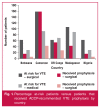Epidemiological African day for evaluation of patients at risk of venous thrombosis in acute hospital care settings
- PMID: 25192298
- PMCID: PMC4170174
- DOI: 10.5830/CVJA-2014-025
Epidemiological African day for evaluation of patients at risk of venous thrombosis in acute hospital care settings
Abstract
Introduction: This study aimed to identify patients at risk for venous thromboembolism (VTE) among all patients hospitalised, and to determine the proportion of at-risk hospital patients who received effective types of VTE prophylaxis in sub-Saharan Africa (SSA).
Methods: A multinational, observational, cross-sectional survey was carried out on 1 583 at-risk patients throughout five SSA countries.
Results: The prevalence of VTE risk was 50.4% overall, 62.3% in medical and 43.8% in surgical patients. The proportion of at-risk patients receiving prophylaxis was 51.5% overall, 36.2% in medical and 64% in surgical patients. Low-molecular weight heparin was the most frequently used prophylactic method in 40.2% overall, 23.1% in medical and 49.9% in surgical patients.
Discussion: This study showed a high prevalence of VTE risk among hospitalised patients and that less than half of all at-risk patients received an American College of Clinical Pharmacy-recommended method of prophylaxis.
Conclusion: Recommended VTE prophylaxis is underused in SSA.
Figures
Similar articles
-
Venous thromboembolism risk and prophylaxis in the acute hospital care setting--results of the ENDORSE study in Poland.Pol Arch Med Wewn. 2008 Oct;118(10):555-61. Pol Arch Med Wewn. 2008. PMID: 19112816
-
[Results of ENDORSE-2-HUNGARIA study. Repeated assessment of the prevalence of venous thromboembolism risk and prophylaxis in acute hospital care setting].Orv Hetil. 2010 May 23;151(21):843-52. doi: 10.1556/OH.2010.28895. Orv Hetil. 2010. PMID: 20462844 Hungarian.
-
[Results of ENDORSE study in Hungary. Multinational, cross-sectional study to assess the prevalence of venous thromboembolism risk and prophylaxis in acute hospital care setting].Orv Hetil. 2008 Nov 2;149(44):2069-76. doi: 10.1556/OH.2008.28488. Orv Hetil. 2008. PMID: 18952526 Hungarian.
-
Assessing, preventing, and treating venous thromboembolism: evidence-based approaches.Am J Health Syst Pharm. 2007 Jun 1;64(11 Suppl 7):S5-13. doi: 10.2146/ajhp070108. Am J Health Syst Pharm. 2007. PMID: 17519445 Review.
-
Prophylaxis against venous thromboembolism in orthopedic surgery.Chin J Traumatol. 2006 Aug;9(4):249-56. Chin J Traumatol. 2006. PMID: 16849000 Review.
Cited by
-
Incidence of Venous Thromboembolism, Risk Factors and Prophylaxis in Hospitalized Patients in the South West Region of Cameroon.Vasc Health Risk Manag. 2020 Jul 22;16:317-324. doi: 10.2147/VHRM.S205935. eCollection 2020. Vasc Health Risk Manag. 2020. PMID: 32801728 Free PMC article.
-
Proximal deep vein thrombosis among hospitalised medical and obstetric patients in Rwandan university teaching hospitals: prevalence and associated risk factors: a cross-sectional study.BMJ Open. 2019 Nov 25;9(11):e032604. doi: 10.1136/bmjopen-2019-032604. BMJ Open. 2019. PMID: 31772101 Free PMC article.
-
Venous Thromboembolism Risk and Adherence to Pharmacological Thromboprophylaxis in Hospitalized Patients in Uruguay: First Nationwide Study.Clin Appl Thromb Hemost. 2024 Jan-Dec;30:10760296241256368. doi: 10.1177/10760296241256368. Clin Appl Thromb Hemost. 2024. PMID: 38798129 Free PMC article.
-
Risk, incidence and predictors of venous thromboembolism among patients attending the emergency department of tertiary care hospitals in Addis Ababa city, Ethiopia: a multicentre prospective study.BMJ Open. 2025 Jan 14;15(1):e091364. doi: 10.1136/bmjopen-2024-091364. BMJ Open. 2025. PMID: 39809560 Free PMC article.
-
The rational use of thromboprophylaxis therapy in hospitalized patients and the perspectives of health care providers in Northern Cyprus.PLoS One. 2020 Jul 15;15(7):e0235495. doi: 10.1371/journal.pone.0235495. eCollection 2020. PLoS One. 2020. PMID: 32667938 Free PMC article.
References
-
- Anderson FA Jr, Wheeler HB, Goldberg RJ, Hosmer DW, Patwardhan NA, Jovanovic B. et al. A population-based perspective of the hospital incidence and case-fatality rates of deep vein thrombosis and pulmonary embolism. The Worcester DVT Study. Arch Intern Med. 1991;151:933–938. - PubMed
-
- Heit JA, O’Fallon WM, Petterson TM, Lohse CM, Silverstein MD, Mohr DN, Melton LJ 3rd.. Relative impact of risk factors for deep vein thrombosis and pulmonary embolism: a population-based study. Arch Intern Med. 2002;162:1245–1248. - PubMed
-
- Samama MM, Cohen AT, Darmon J-Y, Desjardins L, Eldor A, Janbon C. et al. A comparison of enoxaparin with placebo for the prevention of venous thromboembolism in acutely ill medical patients. Prophylaxis in Medical Patients with Enoxaparin study group. N Engl J Med. 1999;341:793–800. - PubMed
-
- Leizorovicz A, Cohen AT, Turpie AG, Olsson CG, Vaitkus PT, Goldhaber SZ. et al. Randomized, placebo-controlled trial of dalteparin for the prevention of venous thromboembolism in acutely ill medical patients. Circulation. 2004;110:874–879. - PubMed
-
- Cohen AT, Davidson BL, Gallus AS, Lassen MR, Tomkowski W, Turpie AGG. et al. Fondaparinux for the prevention of VTE in acutely ill medical patients. Blood. 2003;102 abstract 42.
Publication types
MeSH terms
Substances
LinkOut - more resources
Full Text Sources
Other Literature Sources
Medical
Research Materials


